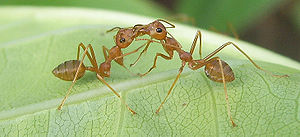
Trophallaxis
Encyclopedia

Community
The term community has two distinct meanings:*a group of interacting people, possibly living in close proximity, and often refers to a group that shares some common values, and is attributed with social cohesion within a shared geographical location, generally in social units larger than a household...
through mouth-to-mouth (stomodeal
Stomodeum
The stomodeum, also called stomatodeum or stomatodaeum, is a depression between the brain and the pericardium in an embryo, and is the precursor of the mouth and the anterior lobe of the pituitary gland.-Structure:...
) or anus-to-mouth (proctodeal
Proctodeum
A proctodeum is the back ectodermal part of an alimentary canal. It is created during embryogenesis by a folding of the outer body wall. It will form the lower part of the anal canal, below the pectinate line, which will be lined by stratified squamous non-keratinized and stratified squamous...
) feeding. It is most highly developed in social insects such as ant
Ant
Ants are social insects of the family Formicidae and, along with the related wasps and bees, belong to the order Hymenoptera. Ants evolved from wasp-like ancestors in the mid-Cretaceous period between 110 and 130 million years ago and diversified after the rise of flowering plants. More than...
s, termite
Termite
Termites are a group of eusocial insects that, until recently, were classified at the taxonomic rank of order Isoptera , but are now accepted as the epifamily Termitoidae, of the cockroach order Blattodea...
s, wasp
Wasp
The term wasp is typically defined as any insect of the order Hymenoptera and suborder Apocrita that is neither a bee nor an ant. Almost every pest insect species has at least one wasp species that preys upon it or parasitizes it, making wasps critically important in natural control of their...
s and bee
Bee
Bees are flying insects closely related to wasps and ants, and are known for their role in pollination and for producing honey and beeswax. Bees are a monophyletic lineage within the superfamily Apoidea, presently classified by the unranked taxon name Anthophila...
s. The word was introduced by the entomologist William Morton Wheeler
William Morton Wheeler
William Morton Wheeler, Ph.D. was an American entomologist, myrmecologist and Harvard professor.-Early life:...
in 1918. The behaviour was used in the past to support theories on the origin of sociality in insects. The Swiss psychologist and entomologist August Forel also believed that food sharing was key to ant society and he used an illustration of it as the frontispiece
Book frontispiece
A frontispiece is a decorative illustration facing a book's title page. The frontispiece is the verso opposite the recto title page. Elaborate engraved frontispieces were in frequent use, especially in Bibles and in scholarly books, and many are masterpieces of engraving...
for his book The Social World of the Ants Compared with that of Man.
In ants, individual colony members store food in their crops and regularly exchange it with other colony members and larvae to form a sort of "communal stomach" for the colony. In termites and cockroaches, proctodeal trophallaxis is crucial for replacing the gut endosymbionts that are lost after every molt. This should not be confused with coprophagia
Coprophagia
Coprophagia or coprophagy is the consumption of feces, from the Greek κόπρος copros and φαγεῖν phagein . Many animal species practice coprophagia as a matter of course; other species do not normally consume feces but may do so under unusual conditions...
.
Some vertebrate
Vertebrate
Vertebrates are animals that are members of the subphylum Vertebrata . Vertebrates are the largest group of chordates, with currently about 58,000 species described. Vertebrates include the jawless fishes, bony fishes, sharks and rays, amphibians, reptiles, mammals, and birds...
s such as bird
Bird
Birds are feathered, winged, bipedal, endothermic , egg-laying, vertebrate animals. Around 10,000 living species and 188 families makes them the most speciose class of tetrapod vertebrates. They inhabit ecosystems across the globe, from the Arctic to the Antarctic. Extant birds range in size from...
s and wolves also feed their young through trophallaxis. Also vampire bat
Vampire bat
Vampire bats are bats whose food source is blood, a dietary trait called hematophagy. There are three bat species that feed solely on blood: the Common Vampire Bat , the Hairy-legged Vampire Bat , and the White-winged Vampire Bat .All three species are native to the Americas, ranging from Mexico to...
s are noted for this behavior.
Trophallaxis serves as a means of communication
Animal communication
Animal communication is any behavior on the part of one animal that has an effect on the current or future behaviour of another animal. The study of animal communication, is sometimes called Zoosemiotics has played an important part in the...
, at least in bees
Bee learning and communication
Honey bees learn and communicate in order to find food sources and for other means.-Learning:Learning is essential for efficient foraging. Honey bees are unlikely to make many repeat visits if a plant provides little in the way of reward...
and ants. In some species of ants, it may play a role in spreading the colony odour that identifies members.

